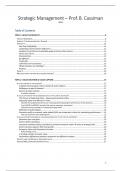Resume
Samenvatting Strategic Management 2024 - Prof. Bruno Cassiman (KU Leuven)
- Établissement
- Katholieke Universiteit Leuven (KU Leuven)
Very complete summary of everything we saw in the lessons. Contains a formulary and various schema's for the topics. In short, everything you need to study to succeed. :) Good luck
[Montrer plus]












